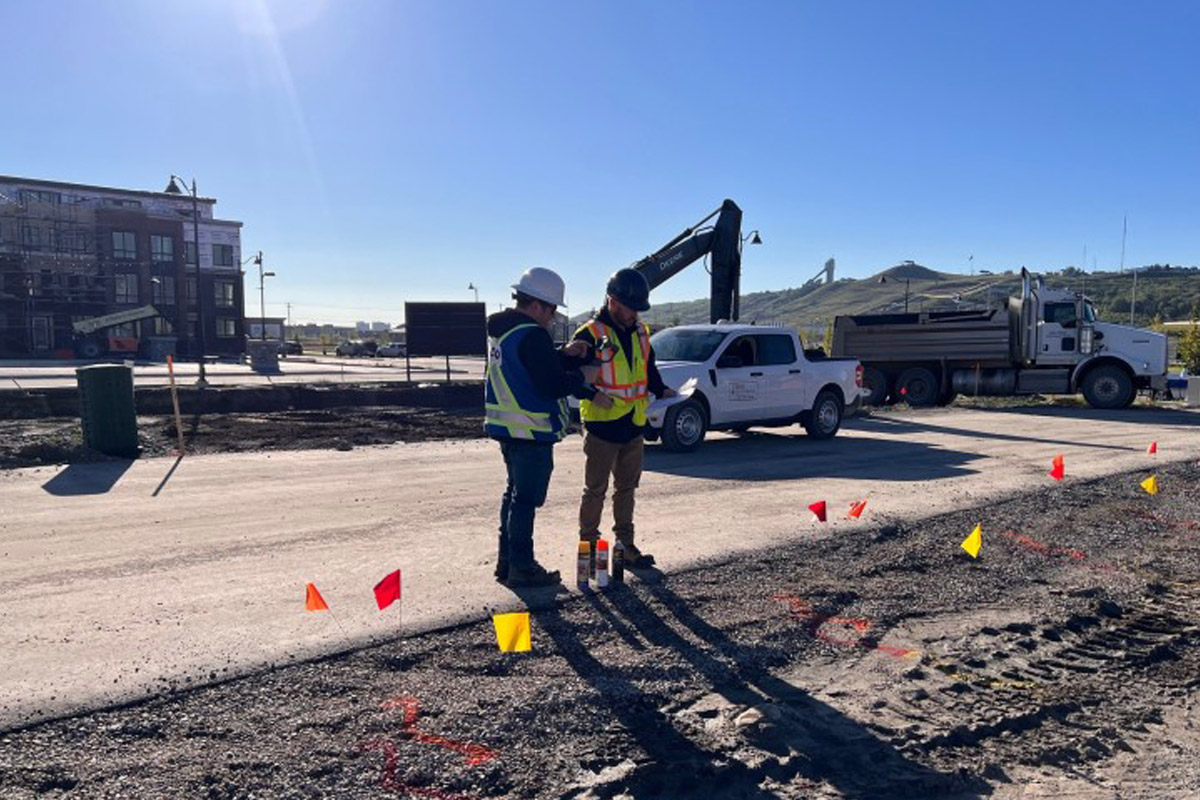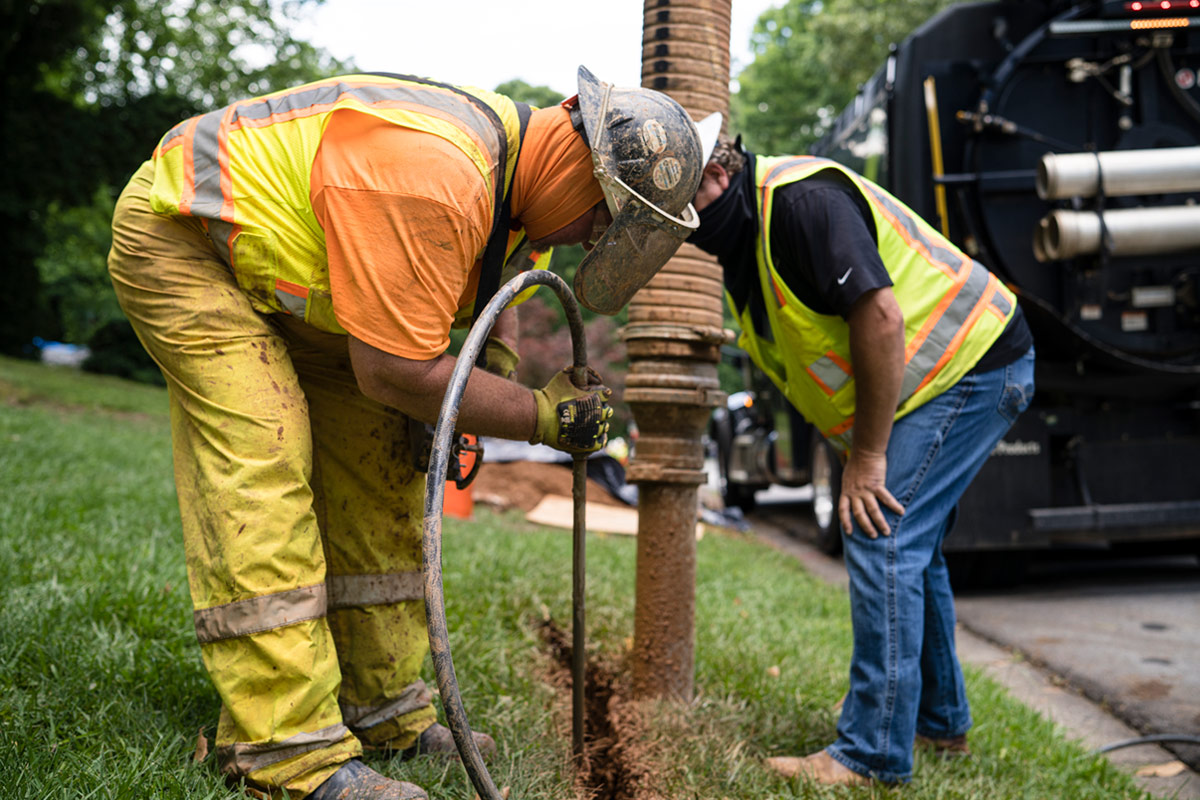
Infrastructure Spending: Could 2021 Be the Year?
Industry Associations Are Keeping Their Eyes and Ears on What’s Going on in Washington, D.C.
Participants for our Editorial Roundtable are:
 KATE FOX Wood
KATE FOX Wood
AEM Senior Director of Government Relations
 EBEN WYMAN
EBEN WYMAN
Represents NUCA and is principal of Wyman & Associates
 STEVE DYE
STEVE DYE
NASSCO Government Relations Consultant
 KRISTINA SURFUS
KRISTINA SURFUS
NACWA Managing Director of Government Affairs
When it comes to infrastructure spending in recent years, it’s been a lot of talk and little action. When it comes to specifically targeting our water and wastewater systems in these discussions, there has been even less talk. All the politicians want to talk about it seems is our highways and bridges.
Could this be the year that comprehensive infrastructure legislation is passed and could this legislation include significant funding specifically for our continually aging and deteriorating water and wastewater systems, as well as stormwater structures? There is optimism that a funding package can be passed and passed with bipartisan approval.
Sounds too good to be true so we wanted to tap into the minds of those who keep tabs on such matters. We reached out several industry associations for their perspective on what is happening with President Biden’s proposed $1 trillion-plus infrastructure package. To date, this proposal is going back and forth between the Administration and Congress. Will a compromise be reached and will water and wastewater systems be included?
Those are the big questions. Here is what our friends who serve the governmental relations aspects of associations are saying.

ASCE recently released its 2021 Infrastructure Report Card. Drinking water received a C- and wastewater a D+. What were some of the key takeaways from this report and impact on the underground infrastructure industry?
KATE FOX WOOD: The 2021 Infrastructure Report card reiterated several things that another AEM-supported report, “Rebuild with Purpose,” recently highlighted, namely the need to invest in broadband infrastructure. For the underground infrastructure industry, the continued attention this issue is receiving from Capitol Hill and the White House should be encouraging. “Rebuild With Purpose” points out the coverage uncertainty that still exists and data that is needed to determine where to prioritize federal investment either through fiber wireline, high-speed wireless (including 5G), or both.
EBEN WYMAN: While the latest ASCE report card has never been one that Mom would put on the refrigerator, some progress has been made. About 10 years ago both water and wastewater infrastructure were getting a consistent D- grade. I’d say efforts to replace lead pipe in drinking water systems across the country have led to the improved grade for drinking water. That said, a C- leaves much room for improvement, and it looks like Congress is looking to step up its commitment for America’s environmental infrastructure, which is long overdue.
STEVE DYE: ASCE’s grades underscore one of NASSCO’s top priorities with Congress: There is a desperate need nationally for increased federal funding for underground water infrastructure. ASCE’s report is based on a variety of data, including the EPA’s Clean Watershed Needs Survey, which shows that $163 billion is needed for wastewater and stormwater collections systems repairs, upgrades, expansion, CSO remediation and stormwater management. ASCE’s report gives a grade that reflects this huge need for increased funding to repair and maintain our buried water infrastructure. It is also important to note that for the first time, ASCE gave a grade for stormwater infrastructure, which received a D. Municipal stormwater collections systems nationwide are in critical need of repair and maintenance.
KRISTINA SURFUS: ASCE’s latest Report Card shows that despite the diligent efforts of the water sector to maintain and invest in clean and safe water and address new and growing challenges, the continued needs are massive and will be a persistent challenge for the foreseeable future. It also shows the scope of opportunity: for continued investment to improve water quality, to support good jobs, to meet these challenges with an eye toward greater resiliency and innovation.
Before getting into specifics, from your position, what is the outlook for water and wastewater spending vs. past years?
FOX WOOD: I would offer that the outlook at federal legislative level is positive. The Senate has taken action on the Drinking Water and Wastewater Infrastructure Act of 2021, that sets funding levels for that program at historic levels, and the House is readying a similar bill. AEM has been vocal about its support for these efforts. This legislation could be separate or in addition to the investment levels proposed by President Biden’s American Jobs Plan.
WYMAN: The outlook in terms of funding is as good as I can remember. The Biden administration and House Democrats who serve on committees with jurisdiction are pushing for about $100 billion for clean water and safe drinking water systems. On top of that, we’re still pushing for lifting the state volume cap on exempt facility bonds (also known as private facility bonds) for water infrastructure, which would open the door for unlimited private investment.
DYE: It is very encouraging to see that Congress and the Biden Administration have made increased federal funding for water infrastructure a top priority in a potential major infrastructure package. While there is still a way to go in a final package coming together, the fact that the House, Senate and Biden Administration have proposals that will sizably boost water infrastructure funding is significant and lends hope that an agreement will be reached in 2021.
SURFUS: At a federal level, the outlook for water and wastewater spending is strong. The critical nature of clean water has become increasingly well understood, and prioritized, among policymakers and the pandemic really drove home water’s importance to public health. A great example of this was with the American Rescue Plan that passed into law this March. The law provided $350 billion in fiscal relief funds to states and local governments to help them recover from the pandemic. Necessary investments in water, sewer and broadband infrastructure were explicitly identified as eligible expenses alongside COVID-19 costs, aid to businesses and households and essential worker premium pay. These funds opened the door to local and state governments to provide influxes of rare federal grant dollars to local water and sewer projects, and they will be supporting important projects in communities around the country. The COVID-19 packages also provided first-ever federal funding that can be used for low-income water/wastewater customer assistance. From the perspective of infrastructure investment, we think this is important because the ability – and inability – of customers to pay water and sewer rates is often a limiting factor for greater infrastructure investment. A federal safety net for water – like what has long been available for energy bills – would target relief to those most in need, and better position utilities to charge the true cost of service to support safe and reliable infrastructure.
The White House, U.S. Senate, and U.S. House all have put forth proposals for increasing annual funding to core clean water programs such as the State Revolving Funds, and water has been a clear priority to the ongoing infrastructure investment debate.
President Biden and Congress are in the back-and-forth period for the Administration’s Infrastructure proposal, in fact the president recently submitted a slimmed down version of his $1.7 trillion plan. What type of impact on underground infrastructure do you see from the Biden administration and the proposal?
FOX WOOD: The American Jobs Plan includes $110 billion for water infrastructure and upgrades. It also includes added investments in other infrastructure assets that would benefit underground infrastructure such as broadband ($100 billion), power infrastructure ($100 billion), and even electric charging infrastructure, of which about 10 percent included in the American Jobs Plan is connected to hard assets like charging stations.
WYMAN: The back and forth will continue, but I’m optimistic that a final bill will include big increases in funding for underground infrastructure improvements. Water and sewer systems, but also significant funding for broadband deployment and projects to harden the nation’s electric grid. A surface transportation bill is also in the works, and there is considerable work for utility relocation that is funded by transportation legislation.
DYE: The details of President Biden’s proposal are still fairly high-level, with a proposed $56 billion to “upgrade and modernize” drinking water, wastewater and stormwater infrastructure for “grants and low-interest loans.” The proposal emphasizes the importance of funding to address environmental justice, climate change, and sustainability, all of which are things that increased funding for underground infrastructure will help address. For instance, more money to repair and upgrade CSO collections systems will address environmental justice, climate change and sustainability. Fixing leaking sewer pipes address environmental justice and sustainability of sewer systems.
SURFUS: While the back and forth continues over the scope, size and bipartisan prospects for an Infrastructure Bill, water/wastewater investment has been a prominent feature throughout the negotiations. Should a final Infrastructure Bill be advanced into law, we are confident that it will have notable increases in water/wastewater funding alongside roads and other key infrastructure sector, however the exact nature and scale of the investment is still unclear.

What is the best we can hope for when it comes to water and wastewater components of this plan? And is that best case scenario feasible?
FOX WOOD: Honestly, the best scenario is that this legislation works its way through a bipartisan process and doesn’t fall into the partisan trap. AEM has been emphasizing this to the White House and to leadership on Capitol Hill. We remain optimistic that both sides want to achieve consensus on this issue and finally make this long overdue investment in our nation’s roads, bridges, highways, ports, airports and underground infrastructure.
WYMAN: It’s a promising scenario. The lowest funding levels proposed are included in legislation recently passed in the Senate, which would authorize $35 billion for water and wastewater infrastructure. I don’t anticipate we’ll see $100 billion, but even $35 to $40 billion over five years would mark significant funding increases for dilapidated water and wastewater infrastructure. I’d say in the end we’ll be looking at $50 to $ 60 billion in total, and policy will prioritize replacement of lead pipe in the nation’s drinking water systems.
DYE: President Biden’s proposal is a starting point in the negotiations process. The Republicans in Congress made a counter-offer, and the bills in the House and Senate have different funding levels. What will be critical is that all sides realize that the nation’s underground water infrastructure needs significant federal funding and they will need to work to agree on an amount that will help their constituents and communities. For NASSCO, we’re pushing hard to make sure there is both a significant long-term increase in federal funding for water infrastructure, as well as more of that funding in the form of grants, and not more loans.
SURFUS: The best case scenario is that water and wastewater remain recognized as essential components of the plan and we see an infusion of new federal spending, primarily through grants, going out to states and local communities around the country. The Biden Administration’s plan set a high water mark of $111 billion for water/wastewater, and we would like to see Congress hew closely to that level of funding as negotiations advance. To be clear, this level of funding would not change the dynamic that water and wastewater investment in this country is overwhelmingly paid for by customer rates, local and state dollars – but it would provide a shot in the arm to advance infrastructure investment and support a stronger federal cost-share for meeting clean and safe water obligations.
Every administration makes promises when it comes infrastructure but execution and follow through don’t always occur. What are the differences you are seeing between the previous Administration vs. the current one when it comes to getting an infrastructure package passed?
FOX WOOD: At the time of this interview, negotiations between the White House and Capitol Hill are actively happening on an infrastructure proposal. That active (and hopefully good faith) back-and-forth has not been the norm over the past few years.
WYMAN: The Trump Administration generally focused on the permitting process related to infrastructure projects. The big difference in the Biden administration is a clear willingness to increase funding for federal water and wastewater infrastructure programs overseen by the Environmental Protection Agency and the Department of Agriculture, but funding levels remained stagnant under the previous administration. While industry will have to deal with certain climate change and labor policy, the proposed funding levels for water and wastewater would make a very big difference.
DYE: As I said in my previous answers, President Biden has released a proposal with some high-level details. He has also indicated he’s willing to have meaningful negotiations with Republicans. Those are encouraging first steps. Let’s hope that momentum continues and the nation will finally get a much-needed boost in water infrastructure funding.
SURFUS: One key difference is that this go-round, there are stronger bipartisan negotiations happening between the White House and Congress. It remains to be seen (as of this writing) whether those will bear fruit and lead to a bipartisan spending deal, or not. Another key difference between the current and previous Administration’s efforts are the focus of the conversation. The Trump Administration prioritized spurring private investment in infrastructure rather than public investment, which kind of fell flat – most sectors seemed to agree private investment has a place but may not be a panacea for the nation’s infrastructure investment backlog. The Biden Administration is focused on building back “better”, which includes ensuring that investments are made with an eye toward future resiliency and innovation. This focus has been generally well-received, although it remains to be seen how exactly those goals will translate into provisions in any final package.
Talk about the recently passed S.914, the Drinking Water and Wastewater Infrastructure Act of 2021. What impact will it ultimately have? What other legislative and funding programs are out there?
FOX WOOD: AEM strongly supported the passage of S. 914 and the bipartisan approach that the Environment and Public Works Committee pursued in teeing it up. The House is working on its proposal currently, and AEM looks forward to supporting those efforts. It sets a precedent for other infrastructure legislation to following this Congress, and the success that process can have if it’s a bipartisan one. Water and wastewater infrastructure bills have traditionally been standard-bearers for infrastructure legislation, and that “reputation” so to speak means that the industry is likely to continue to see predictability in the reauthorization of these programs, which is not something that all infrastructure legislation has going for it (namely federal surface transportation programs).
WYMAN: While funding levels were lower in the Senate bill, enactment of this bill would reflect a needed commitment to repairing water, sewer and stormwater systems. S. 914 would authorizes some $14 billion for EPA’s Clean Water State Revolving Fund (SRCF) and Drinking Water SRF programs and additional resources to fund projects to address combined sewer overflows. The bottom line is if the “floor” is $35 billion, that’s not nearly what is needed but it does show a commitment to start funding these critical projects .
DYE: S. 914’s passage was very encouraging, and it includes a number of NASSCO’s top priorities, such as a significant increase in the Clean Water State Revolving Fund (SRF), including more of that funding to be used as grants and other favorable loan terms. The bill also reauthorizes and boosts funding for the new EPA Sewer Overflow and Stormwater Reuse Municipal Grants (OSG) program, which NASSCO advocated for the creation of in 2018. Overall, the $35 billion over five years bill is a great bipartisan package out of the Senate and NASSCO endorsed it.
NASSCO also endorsed H.R. 1915, the Water Quality Protection and Jobs Creation Act of 2021, which is currently being drafted in the House. That bill will provide $50 billion over five years for wastewater and stormwater infrastructure. It too reauthorizes and increases funding for the Clean Water SRF and OSG programs. It also gives a $2.5 billion in funding to the State agencies that run the water pollution compliance programs, which will generate more underground infrastructure inspections and repair work for NASSCO’s members. H.R. 1915 is expected to move through the House Transportation & Infrastructure Committee in the coming weeks, and hopefully off the House floor in June or July.
Ultimately, the House and Senate bills will need to be negotiated into a final agreement. As I mentioned earlier, NASSCO is supportive of the final package having long-term increased funding and more funding as grants, and not more loans. Many of the provisions in both bills are in NASSCO’s federal policy priorities document, which is available on NASSCO’s website. We’re hopeful that Congress includes our recommendations in the final agreement.
SURFUS: S.914 is important because it would reauthorize and support incremental growth in core programs like the Clean Water State Revolving Fund, which hasn’t been reauthorized since it was created in the 1990s. S.914 also authorizes some new initiatives, including calling on U.S. EPA to do a needs assessment of water and wastewater affordability around the country. While the nation’s focus is on what could happen “this year” in terms of an infrastructure stimulus, bills like S.914 are also key as they will help ensure a strong future year in and year out for core water programs. The bill’s 89-2 passage also shows there is strong bipartisan support for water and wastewater issues. The Senate’s bill will now need to be conferenced with the House’s proposal before anything can be signed into law.
What can be done to shine more light on the state of underground infrastructure, ensuring the needed dollars will be included in any legislation?
FOX WOOD: AEM has always emphasized the need for a diverse group of stakeholders to weigh in on the topic of infrastructure — and that includes underground infrastructure. We continue to serve as a leader and convener for an informal coalition of industry groups who include underground infrastructure in their “infrastructure” definition. Ensuring that policymakers know the scope of industries supported by underground infrastructure, the millions employed by the underground infrastructure industry, and frankly, the down right necessity of the underground infrastructure industry, cannot be overstated.
WYMAN: As an association lobbyist, I’ve always said the key to influencing the federal government is through a strong grassroots network of citizen lobbyists. Nothing is more important than industry members show up to make the case for increased investment in American infrastructure. Nothing beats when “real people” weigh in with policymakers and make the case that these projects are needed. This year is shaping up to be a very big one for infrastructure investment, but I’d suggest any industry folks weigh in early and often with policymakers at the federal and state level.
DYE: This question is really the most important question because Congress hearing from their constituents is critical to getting increased funding for underground water infrastructure. A recent survey of Members of Congress found that when they’re undecided on an issue, 95 percent of them were more influenced by hearing from constituents than they were from any other sources, such a media, lobbyists, or academia. Representatives and Senators want to get re-elected, so when they hear from their constituents that more federal funding for underground water infrastructure is needed back home, they will do all they can to make that happen. The more constituents they hear from, the harder they will work to get more funding.
NASSCO’s Sewer System Heroes grassroots advocacy program makes is extremely easy for our members and anyone working in the water sector to write their Members of Congress to ask for more funding for underground water infrastructure. Text PIPE to 25994, and a link will be sent to the Sewer System Heroes website at nassco.org. All someone needs to do is hit send on a pre-written email letter and it will go to their Members of Congress. It literally takes two minutes, but the impact can amount to billions of dollars per year in increased federal funding for underground water infrastructure.
SURFUS: Get engaged with national and professional organizations you may belong to and leverage opportunities or resources they may have, such as draft letters or fact sheets, to reach out to your Members of Congress. It’s key that we keep highlighting the needs, as well as all the benefits, that increased investment can bring to States and Congressional Districts around the country.




